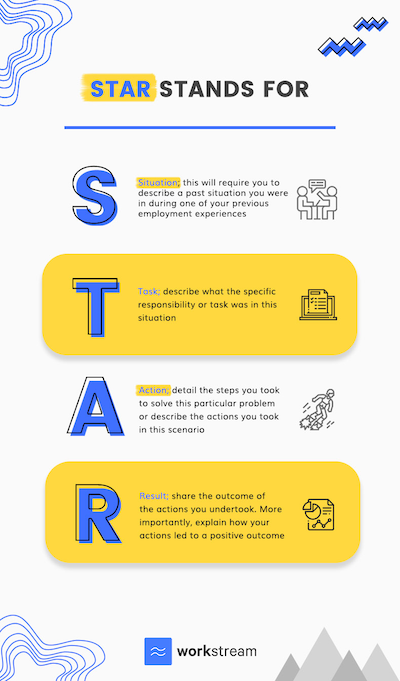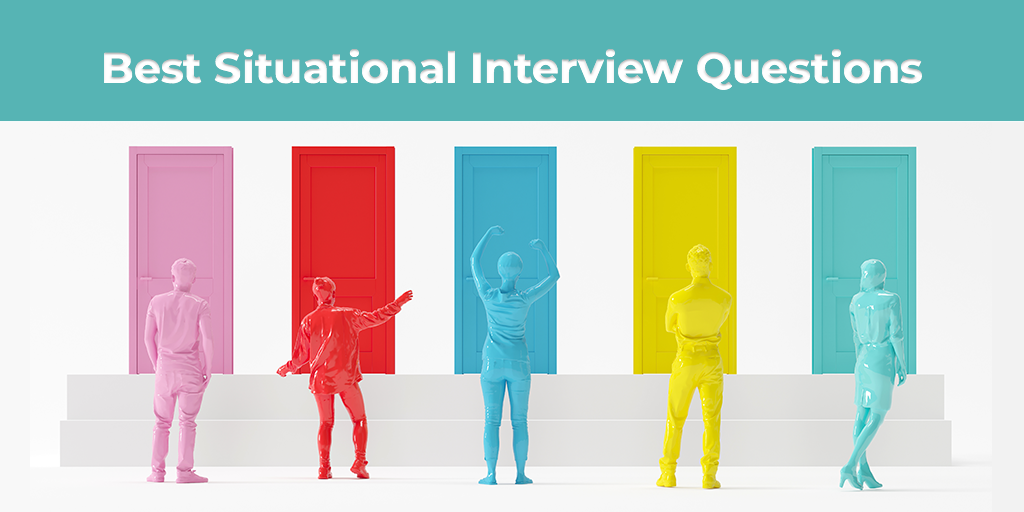Interviewing for a job is stressful, but you can still excel in your interviews if you dedicate enough time to prepare. That's what the STAR Method is all about.
Having worked with over 5000+ hiring managers from Chick-fil-A to Uber, we’ve put together this ultimate interview guide. Specifically, we’ll take a deep dive into Behavioral Questions, and why the STAR Method is the key to acing them.
Types of interview questions
Before digging deeper into what the STAR Method is and how it works, it is important to understand the different types of interview questions that are commonly asked. Two of the most popular types of interview questions are situational interview questions and behavioral interview questions.
Situational interview questions are questions that place an interviewee in a hypothetical situation. These types of questions aim to help interviewers understand how you would react in a particular situation, even if you’ve never experienced it before. One such example would be the question, “You’ve made a mistake that no one else noticed. What would you do in such a situation?”
These situational-based questions can be helpful for managers when interviewing applicants who have no prior experience in the industry that they’re seeking a job in. These are also considered to be future-oriented situations that interviewers anticipate you may face, should you be offered this role.
On the contrary, behavioral interview questions are part-oriented. Instead of placing interviewees in a hypothetical situation, you will be asked to describe a situation from your past experiences, often requiring you to describe situations from your previous job.
At the core of behavioral questions, your interviewers are asking you to tell them a story. Through this recount, interviewers are trying to better understand how you think and approach different situations. Most importantly, they are trying to assess if they can potentially work with you, and decide if you are a good fit in the company culture. An example of a behavioral interview question would be “Describe a situation when you had to work with someone whom you disliked as a person?”
According to hiring managers we work with, most of their successful candidates adopt the STAR method of answering to tackle behavioral interview questions effectively.
What is the STAR interview method?

Having a great experience to share with your interviewer isn’t sufficient if you fail to communicate it effectively. The STAR Method allows you to present your answer in a more structured and coherent manner. This allows interviewers to be able to follow your narrative easily.
10x your odds of acing an interview
Great, now you know what the STAR Method is. But there’s still much to be done if you want to land that dream job.
Here’s an extremely important tip (we can’t stress this enough!) that many interviewees often overlook: WRITE YOUR STORIES DOWN. Before you even step into that interview room, you need to be armed with these preconceived stories and notable moments jotted down. We’re not just referring to the general storyline, but the specific details with carefully selected keywords and phrases. We call this the Story Toolbox.
The Story Toolbox is a detailed library of your stories that are categorized based on some of the most popular behavioral questions. Building this toolbox will take time, but it trust us when we say, it’s worth it.
|
These are the 7 Must-have Story Categories in your Toolbox: 1. Problem: A time when you solved a major problem or saved the day |
Spend some time to ponder about your past work situations that fit in these 7 categories. Ideally, these experiences should have occurred in the last 5 years. Then, proceed to use the STAR Method to document these experiences. You may notice that your stories can fit into multiple categories, and that is perfectly fine. If possible, come up with at least one unique story per category, and strive for two. Note that this list of 7 categories is not exhaustive, but from our statistical data, these are the 7 most common themes when asking behavioral questions.
When noting your stories down, make sure you are concise, and take the time to select notable keywords. Interviewers dread lengthy stories, so be succinct. Having select keywords helps you to recall your stories more readily, even if you can’t recite them verbatim during the actual interview.
Before the interview, take some time to understand the job role that you applied for and the necessary skills and challenges that you may potentially face. Try to structure each of your experiences in your previous job following the STAR Method - start to describe your situation, task, action, and then result.
|
Bonus tip: Oftentimes, interviewees seek to portray themselves differently just to impress their interviewer. Avoid doing this, as interviewers are often able to tell if you are genuine and sincere in your responses. |
Answering an interview question using the STAR Method
Here’s a model example of the STAR Method in action:
Question:
“Tell me about a time you worked with a colleague who was unreliable and didn’t complete the things he said he was going to do.”
This question falls under the “Difficult Co-worker” category, which you are now well-prepared to answer having prepared your Story Toolbox.
Answer:
Situation (S): I was a Team Lead at the previous restaurant I worked at, where I was tasked with leading the morning shift team. Our team size ranged from 10 to 15 employees at any given time.
Task (T): One of my tasks was to coordinate with the other shift managers and put together the weekly food wastage report. A problem arose when one of the night shift managers would constantly tell me that he couldn’t get his reports on time. This often happened right when the deadline was about to hit, and it impacted my ability to do my job in time and deliver my work consistently.
Action (A): While many of my fellow managers suggested that I went straight to senior management, I respected him as a co-worker, and so I took the concern straight to him to talk things through. I first showed empathy and said “I can imagine you have so much you’re working on right now, and I can tell that you’re working hard. I wanted to discuss the past 3 deadlines that we set, and that you weren’t able to meet. When you don’t get me the wastage reports on time, it delays the entire reporting process and leads the rest of us to take several hours to readjust the schedule. Is there a way we can ensure that this doesn’t happen in the future?”
Result (R): While I was nervous about confronting him directly, I felt it was necessary in order to resolve the situation. Thankfully, he opened up to me about how he was also struggling to gather information required for the report from his team members. Having already created a Standard Operating Procedure (SOP) with my own team, I decided to share my routine with him. Knowing full well that each team has its idiosyncrasies, I suggested that we come up with a streamlined solution that fits his team’s work style. With our new solution, his team members had to submit a form with every report request before they could clock out, which has enabled him to compile his numbers on time. Since then, he stopped putting off the task and we were able to generate the report on time.
What is noteworthy about this story, is that it can also be tuned to fit a variety of different questions such as:
- Tell me about a time you had to deal with interpersonal conflict at work
- Tell me about a time you had to deal with a communication breakdown
- Tell me about a time when you took charge when your boss wasn’t around
More examples of answering an interview question using the STAR Method
Let’s try structuring another interview question using the STAR method.
Question:
“Tell me about a time where you had to appease an unsatisfied customer.”
This question falls under the category of “Problem” and “Obstacle”. With the Story Toolbox, you are now fully equipped to take on this question.
Answer:
Situation (S): I was working as a server at a fast-food chain about 2 years ago. It was the peak period at a restaurant, and generally, with peak periods, our staff are often overwhelmed which results in increased waiting times. Unfortunately, these are the same periods in the day in which customers are in a hurry, and patience can sometimes wear thin.
Task (T): During one of the peak dining periods, there was a couple who was dining in and we served one of their meals slightly later than the other person (say 15-20 minutes waiting time in between). They were highly displeased by the delay, especially since they thought the other dish would have been served soon after the first dish was served. In fact, they actually waited for the other dish, and by the time the final plate was served, the first dish was already cold. Evidently, this led to an unpleasant dining experience, and they expressed their frustration to me.
Action (A): I am a firm believer in empathetic listening. After all, we have all been in frustrating situations as a consumer. I first stood by their table and listened attentively to their complaints. Subtle cues like occasional nodding and acknowledgment of our mistakes are, in my opinion, signals to the customer that they are heard. I proceeded to apologize, and shared my appreciation for their feedback. I assured her that as a team, we would continue to work on our processes, and going forward, we’ll inform customers should we anticipate a longer wait between dishes. I then offered a 15% discount after consulting with my manager, along with a dining voucher for their next visit.
Results (R): Thankfully, the customers did not make a huge fuss when I approached them. In fact, one of them shared their appreciation for me listening to their complaints in spite of the crowd. It was definitely encouraging to see their faces during subsequent visits, and we’d even exchange greetings like old friends thereafter. I was glad I took the time to listen to them despite the crowd.
Let’s use the STAR Method for one other common question.
Question:
“Describe a situation where you were under extreme pressure and the steps you’ve taken to ensure that success is achieved.”
We’ve touched on different categories that focus on your problem-solving skills. This question falls under the category of “achievement” where you should emphasize on the actions that you have taken to achieve success.
Answer:
Situation (S): I was a new member of the front-of-house team at a Steakhouse restaurant in Atlantic City. My primary responsibilities were as a server and buster, and two weeks into the job, I was presented with a daunting task.
Task (T): One of my colleagues had to miss work and I was asked to cover their shift. We were extremely short-handed that day, and the manager asked if I had the confidence to take over her role as a cashier. Being a fast-casual steakhouse, ordering and cashiering was undoubtedly complicated. You had to ensure the doneness of each order was entered correctly, and failure to do so could cause the restaurant to incur unnecessary complaints and even wastage should they request for the steak to be redone.
Action (A): I was placed under immense pressure to familiarize myself with the cash register, and there were no other seniors or experienced team members on the team to guide me throughout service. Thankfully, I found a manual of the register and I jotted down the steps that were required on a small post-it and stuck it by the register. While I was not nearly as efficient as some of my co-workers were at cashiering, I found that it was a great opportunity to demonstrate some of my interpersonal skills. I would crack jokes with the customer while taking orders and constantly sought their kind understanding if it took a while longer. Sometimes, I would even make tiny digs at my own speed, saying “How hard could cashiering be right? It’s just a couple of buttons. Jeez, I never understood what took Jasmine so long in the past. Now I know.”
Results (R): To my surprise, most of the customers did not seem to notice or even mind the slightly longer ordering time. I realized that people often feel impatient when disengaged, and my small talk and banter actually positively impacted their dining experience. While it may have been a small accomplishment to many, I felt extremely rewarded by the end of that shift. Apart from learning a new skill set, I think my main takeaway was how important it is to always be personable and relatable. Customer service isn’t just about speed. It’s also about the subtle acts of eye contact, smiles, and the occasional injection of humor.
STAR interview method sample questions
Having seen the STAR Method in action, it’s now your turn to draft your own narratives and build up your Story Toolbox. If you’re feeling exceptionally hard-working, here are some other frequently asked STAR interview method questions you can add to your repertoire.
- Tell me about a time when you made a mistake and nobody knew about it except yourself. What did you do?
- Have you ever been in a situation when you had to follow the policy you didn’t agree with? What did you do?
- Describe a situation when your direct supervisor gave you a task with specific instructions but your manager gave you a different set of instructions without the knowledge of your direct supervisor. How did you solve this?
- Describe a situation where you were placed under extreme pressure at work.
- Describe a situation at work when you were right about something but had to follow your supervisor’s instructions even though they were wrong.
- Describe a situation at work when you had to explain a complex topic to someone who knew very little about the subject and didn’t seem to understand it quickly.
- Tell me about a time when you disagree with your boss, how did you handle this disagreement? Has your relationship with your boss suffered because of that?
- Describe a situation when you set a specific goal and achieved it.
Summing up
Ultimately, the STAR Method is simply a guide for you to express your stories in a coherent manner that offers interviewers the opportunity to understand you better. Remember that your interviewers are actively trying to assess if they and their colleagues can work with you. Use the Star interview method to identify stories that paint you in a better light than before, so be sure to highlight the value you managed to deliver through these recounts.
Check out the Workstream blog for more tips and tricks to acing an interview and conducting a successful one.









































